In an address made on June 16 of last year, President Chen Shui-bian (陳水扁) commented on the possibilities of navel engagement with the Peoples Liberation Army (PLA) in the Taiwan Strait. His comments were met with incredulity by many in the military and sent shivers down the spines of ordinary citizens.
While the possibility of such an offshore engagement is not something that instantly lends itself to humor, several local artists have joined together in order to take a collective, sarcastic and off-the-wall look at the possibilities of such an event.
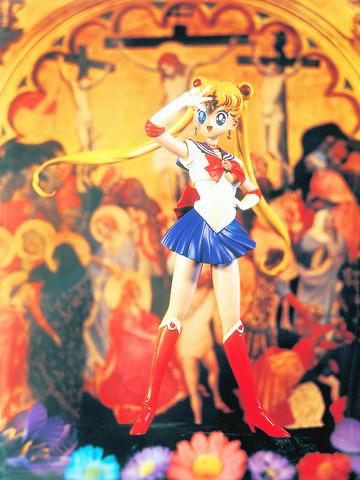
PHOTO: CHERNG PIIN GALLERY
Entitled Iconoclasm to Neo-Iconolatry, the exhibition at the Cherng Piin Gallery sees works by seven artists tackling the issue of war with China and deterioration of society in general.
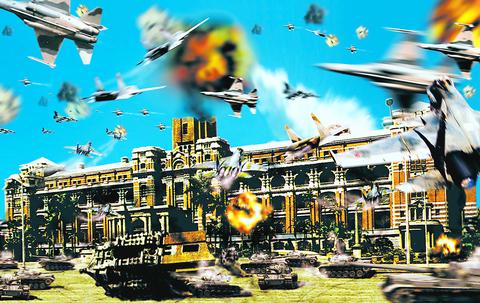
PHOTO COURTESY OF CHERNG PIIN GALLERY
The most prominent of the works on display is by Mei Dean-E (梅丁衍). Returning from the US in 1991 after three years studying Chinese art history under Professor James Cahill at Berkeley, Mei's memories of the post-martial law era in Taiwan remain vivid. Recalling that period today, Mei refers to it as "the era in which everything was deconstructed."
And indeed, deconstruction plays a big part in his latest work. Titled Offshore Engagement (境外決戰), the work depicts jet fighters and bombers attacking four of Taiwan's better known landmarks. The National Palace Museum, the Presidential Office, the Grand Hotel and the Chiang Kai-shek Memorial Hall Plaza, all pictured being unceremoniously leveled by squadrons of the People's Liberation Airforce.
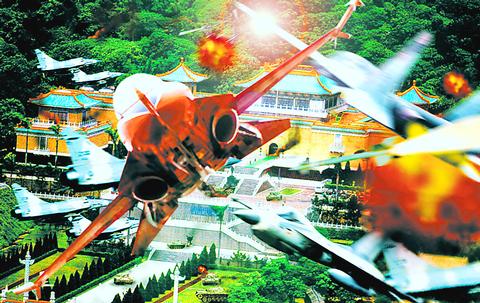
PHOTO: CHERNG PIIN GALLERY
Through the use of computer generated and composite graphics, Mei has created a world that on the outside might appear to be the stuff of nightmares, but within the bombs and chaos lies sarcasm of the blackest variety. Like many, Mei feels the chances of a major naval conflict with China actually taking place are laughable.
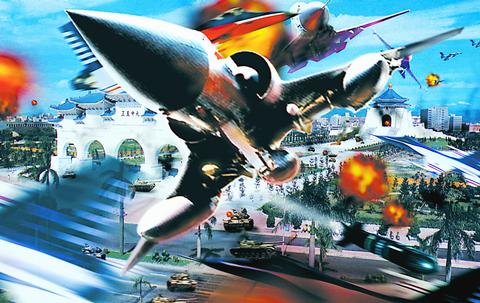
PHOTO COURTESY OF CHERNG PIIN GALLERY
This point is echoed by art critic and curator of the exhibition Jason Wang (王嘉驥), who, while not voicing his opinion on matters of national defense, does feel that the post-martial law era has seen a marked rise in the challenging of authority through the defamation of once sacred political and cultural icons.
Needless to say, deconstruction of such icons features largely in the exhibition. While Mei may be the only artist who dares to level the Presidential Office, the tongue-in-cheek concepts of annihilation and devastation take many forms: such as the comic belittlement of one of the nation's lesser known tourist spots.
Well-known for his Recover the Mainland series, in which he superimposed his own photographic image into shots of several of China's leading tourist attractions, Yao Jui-chung (姚瑞中) has chosen an unusual ally in order to help him tackle the issue of destruction and armed conflict.
With the help of The Little Mermaid and an amusement park located in northern Taiwan, Yao ridicules true love in a commercial world that could come to an untimely and bloody end. The angelic aquatic mermaid is pictured rotting amid the ruins of the devastated amusement park.
Unlike Mei and Yao, artist Hung Tung-lu (洪東祿) has addressed the issue of decimation and defamation without the devastation. Hung isn't going to war with the PLA and is instead making viewers ponder social deterioration and changing values.
With the help of a host of Japanese cartoon characters including Street-Fighter, Chun-li, Sailor Moon, Lynn Minmay, and Evangelion Ayanami Rei, Hung makes viewers look twice at images normally taken for granted.
Slightly altered images of these X-Gen cultural icons have been superimposed over pictures of temples. Hung sees this as indicative of how mass produced items have replaced once solid religious values and truths.
There are contributions from four other artists, all of whom have their own highly personal styles. Works by Chen Chieh-jen (陳界仁), Lin Ju (林鉅), Hsia Yan (夏陽) and Kuo Chen-chang (郭振昌) may not be as hard hitting as those by the other artists, but they remain as sarcastic and as poignant as those of their peers.
Although From Iconoclasm to Neo-Iconolatry is not an exhibition that will appeal to all art lovers, those who enjoy black humor will find something to amuse themselves amongst the exhibits.
Art Notes:
What: rom Iconoclasm to Neo-Iconolatry (從反聖像到新聖像)
Where: Cherng Piin Gallery (誠品畫廊), B2, 245, Sec. 1, Tunhua S. Rd., Taipei (台北市敦化南路一段245號B2)
When: Until June 17
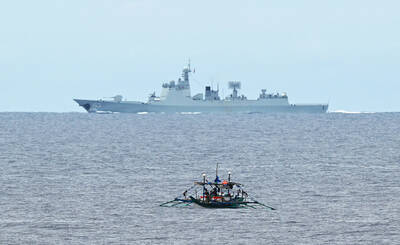
Late last month Philippines Foreign Affairs Secretary Theresa Lazaro told the Philippine Senate that the nation has sufficient funds to evacuate the nearly 170,000 Filipino residents in Taiwan, 84 percent of whom are migrant workers, in the event of war. Agencies have been exploring evacuation scenarios since early this year, she said. She also observed that since the Philippines has only limited ships, the government is consulting security agencies for alternatives. Filipinos are a distant third in overall migrant worker population. Indonesia has over 248,000 workers, followed by roughly 240,000 Vietnamese. It should be noted that there are another 170,000
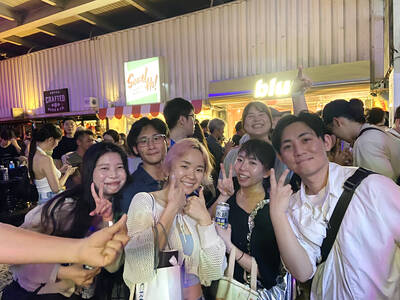
Hannah Liao (廖宸萱) recalls the harassment she experienced on dating apps, an experience that left her frightened and disgusted. “I’ve tried some voice-based dating apps,” the 30-year-old says. “Right away, some guys would say things like, ‘Wanna talk dirty?’ or ‘Wanna suck my d**k?’” she says. Liao’s story is not unique. Ministry of Health and Welfare statistics show a more than 50 percent rise in sexual assault cases related to online encounters over the past five years. In 2023 alone, women comprised 7,698 of the 9,413 reported victims. Faced with a dating landscape that can feel more predatory than promising, many in

“This is one of those rare bits of TikTok fitness advice with a lot of truth behind it,” says Bethan Crouse, performance nutritionist at Loughborough University. “Sometimes it’s taken a bit too literally, though! You see people chugging protein drinks as they’re scanning out of their gym.” Crouse recommends the athletes she works with consume 20-30g of protein within 30-60 minutes of finishing a resistance training session. “The act of exercising our muscles increases the breakdown of muscle proteins,” she says. “In order to restore, or hopefully improve them — and get gains such as increased muscle mass or strength —

“Far from being a rock or island … it turns out that the best metaphor to describe the human body is ‘sponge.’ We’re permeable,” write Rick Smith and Bruce Lourie in their book Slow Death By Rubber Duck: The Secret Danger of Everyday Things. While the permeability of our cells is key to being alive, it also means we absorb more potentially harmful substances than we realize. Studies have found a number of chemical residues in human breast milk, urine and water systems. Many of them are endocrine disruptors, which can interfere with the body’s natural hormones. “They can mimic, block